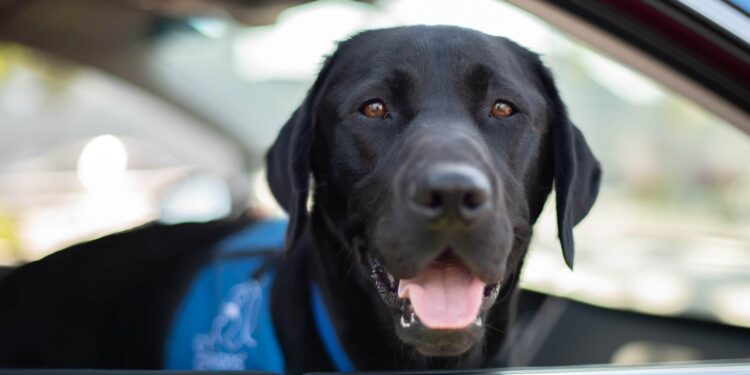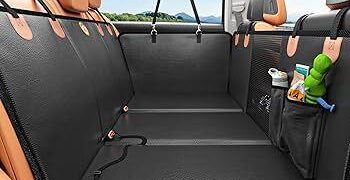Table of Contents
The Mistake That Nearly Cost Me Everything
My journey into the world of canine car safety began with Max, a lanky shepherd mix with soulful eyes and a past I could only guess at.
Adopting him was one of the best decisions of my life, but it came with a challenge: Max was terrified of the car.
Every trip, even to the park, was an ordeal of whining, frantic panting, and trembling that shook his entire body.1
My mission, like that of any loving pet owner, was to make him feel safe and comfortable.
So, I did what most people do.
I went online.
I was immediately overwhelmed by a marketplace flooded with plush, inviting “dog car seats.” They were marketed as the solution to car anxiety, often featuring booster designs that would let a nervous dog see out the window.3
I settled on a popular model—a soft, cushioned booster seat with high walls and what seemed like a thoughtful safety feature: a short tether that clipped directly to his collar.
I thought I was buying a safety device.
I thought I was solving the problem.
In reality, I was setting the stage for a near-disaster.
The moment of truth came on a busy highway.
A car swerved into my lane, forcing me to slam on the brakes.
In the split second of screeching tires and lurching metal, I heard a sickening snap from the back seat.
I glanced in the rearview mirror to a sight that still haunts me: the booster seat had tipped over, and Max, no longer attached to anything, had been thrown violently against the back of the passenger seat.
The flimsy tether had snapped at the clip.
By some miracle, Max was physically unharmed, but the terror in his eyes was a perfect mirror of my own.
That plush seat hadn’t protected him; it had failed catastrophically at the first real test.
It wasn’t a safety device.
It was just furniture.
In that horrifying moment, I realized that the entire market I had trusted was built on a dangerous premise.
The products sold for “comfort” and those sold for “safety” are two entirely different things, yet they are marketed as one and the same.
My mistake was assuming a product designed to soothe my dog’s anxiety would also protect his life.
The evidence I would later uncover proves this is a fatal assumption; many products marketed for comfort, especially booster seats, perform abysmally in crash tests, often becoming projectiles themselves.6
This distinction is the first, most critical step to understanding how to truly keep your dog safe.
The Epiphany: Why We Must Think About Dogs Like We Think About Children
That near-miss on the highway sent me on a mission.
I abandoned the world of pet product marketing and dove headfirst into the one field that has mastered the science of keeping passengers safe in a collision: child restraint engineering.
My epiphany was simple but profound: the unforgiving laws of physics don’t distinguish between a 50-pound child and a 50-pound dog.8
To protect our pets, we must stop thinking of them as cargo and start applying the same rigorous safety principles we use for the most vulnerable human passengers.
This led me to develop a new framework: The Child Safety Standard for Dogs.
This isn’t about treating dogs like babies; it’s about respecting the scientific truths that govern crash dynamics.
The principles that make a child’s car seat safe are universal, and they provide the only reliable lens through which to evaluate any pet restraint system.
These core principles are:
- Managing Crash Forces: A safety system must absorb and distribute the immense forces of a crash across the strongest parts of the body, preventing them from concentrating on fragile areas like the neck or internal organs.11
- Structural Integrity: The restraint itself—the harness, the carrier, the crate—must not break, tear, or deform in a way that compromises containment. Its components must withstand forces many times the dog’s weight.10
- Secure Anchoring: The entire system must be rigidly connected to the vehicle’s structure, typically via the seatbelt or LATCH (Lower Anchors and Tethers for Children) system. An unanchored system becomes part of the danger.13
- Proper Fit and Use: Even the best-engineered product is useless if it doesn’t fit the dog correctly or if it’s installed improperly. Consistent, correct use is non-negotiable.12
My flimsy booster seat and collar tether failed on every single one of these principles.
It didn’t manage forces; it concentrated them on Max’s neck.
Its structural integrity was nonexistent.
Its anchoring was weak.
And its design encouraged improper use.
This new paradigm changed my entire perspective.
The goal was no longer to find a “better dog car seat,” but to find a true safety system that adhered to these non-negotiable laws of physics.
Pillar 1: The Unseen Force – Your Dog as a Projectile
The most critical truth that most pet owners overlook is the brutal physics of a car crash.
When you are driving, your dog is moving at the same speed you are.
In a sudden stop or collision, their body continues moving forward at that speed until it hits something.
The forces involved are staggering.
According to safety experts, an unrestrained 80-pound dog in a 30 mph crash will exert approximately 2,400 pounds of force on whatever it strikes—be it the dashboard, the windshield, or another passenger.16
Even a small 10-pound dog becomes a 500-pound projectile.16
This force is frequently lethal for the pet and can cause severe or fatal injuries to the humans in the car.10
This reality stands in stark contrast to the common reasons owners give for not using a proper restraint.
A survey by AAA and Kurgo revealed that while 83% of owners agree that an unrestrained dog is dangerous, only 16% actually use a safety restraint.16
The excuses are born from a misunderstanding of risk:
- “My dog is calm.” A dog’s temperament is irrelevant in a collision. The forces are external and instantaneous. Furthermore, an unrestrained pet is a major source of driver distraction, with 29% of owners admitting to being distracted by their dog while driving.16
- “It’s just a short trip.” This is perhaps the most dangerous myth. According to the National Highway Traffic Safety Administration (NHTSA), most accidents occur within 25 miles of home, on the very roads we travel every day.17
- “I’m a safe driver.” You cannot control the actions of other drivers. Drunk driving, distracted driving, and simple mistakes by others can force you into a collision with no warning.19
- “I want my dog to be happy.” Allowing a dog to roam freely or hang its head out the window is not a kindness; it’s an exposure to risk. It makes them vulnerable to being struck by debris or being ejected from the vehicle in a crash or even a sharp turn.20
The danger is magnified exponentially when children are in the vehicle.
An unrestrained dog can interfere with the proper deployment of an airbag or, in the worst-case scenario, become a high-velocity projectile that strikes a child, turning a survivable accident into a tragedy.8
Table 1: The Illusion of Safety vs. The Reality of Physics
| Common Belief (“The Illusion”) | Scientific Reality (“The Physics”) |
| “My 10-lb dog is small and harmless.” | At 30 mph, your dog becomes a 300-500 lb projectile, capable of causing fatal injury to itself and others.16 |
| “I only take short trips to the park.” | Most car accidents occur within 25 miles of home, on familiar roads during routine trips.17 |
| “My dog is calm and just lies down.” | 84% of dog owners do not use restraints, despite knowing the danger. A dog’s calmness is irrelevant to the laws of physics in a collision.16 |
| “A simple tether is good enough.” | Untested tethers attached to collars can cause catastrophic neck injury or asphyxiation. Most will fail under crash forces.3 |
| “My dog is safest on my lap.” | An airbag deploys with enough explosive force to kill a pet. The front seat is one of the most dangerous places for them.16 |
Pillar 2: The Wild West – Navigating an Unregulated Market
The reason so many of us make dangerous choices for our pets is not just a lack of awareness; it’s that we are navigating a completely unregulated market.
Unlike child safety seats, which must meet strict federal standards (Federal Motor Vehicle Safety Standard 213, or FMVSS 213) to be sold, there are no government regulations or mandatory safety standards for pet travel products in the United States.9
This regulatory void creates a “Wild West” where manufacturers can make unsubstantiated claims, and consumers are left to fend for themselves.
Deconstructing the “Crash-Tested” Lie
This lack of oversight has given rise to a dangerously misleading marketing term: “crash-tested.” When you see this on a product, you naturally assume it means the product is safe.
However, the term has no legal definition.
A company can slam its product into a wall, watch it shatter into a million pieces, and still legally label it “crash-tested” because they never claimed it passed the test.7
Furthermore, the testing methods themselves are often dubious.
Some companies may test only one size of a product line and apply the claim to all sizes, or they may use testing conditions that don’t accurately simulate the forces of a real-world car crash.21
This systemic failure—from the lack of government regulation to misleading manufacturer claims, often amplified by retailers 22—leaves the consumer with no reliable way to distinguish a safe product from a dangerous one.
The Gold Standard: The Center for Pet Safety (CPS)
In this chaotic landscape, there is one beacon of trust: the Center for Pet Safety (CPS).
The CPS is the only independent, non-profit consumer advocacy organization in the U.S. dedicated to pet product safety.21
Think of them as the Insurance Institute for Highway Safety (IIHS) or Consumer Reports for the pet world.
Because no government standards exist, the CPS created its own.
Their certification protocol is rigorous, based on the federal standards for child safety seats, and is conducted at independent, third-party laboratories.22
They use proprietary, specially designed crash-test dummy dogs that are weighted and instrumented to measure the forces on a dog’s body during a simulated 30-mph collision.24
Crucially, the CPS does not accept funding from pet product manufacturers for its testing or certification, ensuring complete independence and objectivity.21
This is why the
“CPS Certified” logo is the single most important thing to look for.
It is the only seal that guarantees a product has not just been “tested,” but has passed a consistent, scientifically rigorous, and independent safety evaluation.21
Pillar 3: The Anatomy of a Safe System – Harnesses, Carriers, and Crates
Applying the “Child Safety Standard for Dogs” framework allows us to cut through the marketing noise and analyze the three legitimate types of safety systems based on engineering principles.
The question is not just “What did I buy?” but “How does it work to manage a crash?”
The “5-Point Harness” Principle: Safety Harnesses
A child’s 5-point harness is designed to distribute the immense forces of a crash across the strongest parts of their body: the shoulders and hips, with a buckle between the legs.11
This prevents the force from concentrating on the vulnerable neck and abdomen.
A CPS-certified dog harness operates on the same principle.
A product like the Sleepypod Clickit Sport or Terrain uses a three-point design that integrates directly with the car’s seatbelt.29
The seatbelt is threaded through loops on the back of a broad, padded vest that covers the dog’s entire torso.
In a crash, this system distributes the force evenly across the dog’s chest and back, minimizing rotation and preventing the dog from being launched from the seat.24
This is fundamentally different from simply clipping a tether to your dog’s walking harness or collar.
A walking harness is not built to withstand crash forces and will likely tear, and attaching any restraint to a collar is a recipe for severe neck injury or strangulation.3
CPS explicitly advises against using any restraint with a long extension tether, as this allows the dog to build up dangerous momentum before the restraint engages, increasing the force of the final impact.22
The “Secure Cocoon” Principle: Carriers and Crates
A child’s car seat is, in essence, a rigid cocoon designed to maintain its structural integrity and contain the child.
The same principle applies to CPS-certified carriers and crates, where the primary goal is total containment.
- Carriers (for Small Dogs & Cats): These products are designed for smaller pets (typically under 20-30 lbs) and are secured directly to the vehicle’s back seat using the seatbelt. During CPS testing, certified carriers like the Diggs Passenger or Sleepypod Mobile Pet Bed prove that their structure remains intact, the zippers do not burst open, and the carrier stays anchored to the seat.22 In contrast, many non-certified soft-sided carriers disintegrate on impact, ejecting the pet.36
- Crates (for Medium to Large Dogs): For larger dogs, a robust, hard-sided crate secured in the cargo area of an SUV or wagon is a top-tier safety option. CPS-certified crates, such as those from Gunner Kennels, are made from materials like double-wall rotomolded plastic and feature strong door latches and integrated anchor points.37 They are secured using strength-rated tie-down straps—not bungee cords—to the vehicle’s cargo anchors.39 Standard wire or thin plastic travel crates are not designed for crash protection and are known to shatter or collapse under impact forces, failing to contain the dog.36
The debate between a harness and a crate is nuanced.
While many believe a crate is the absolute safest option 42, some first responders and biomechanics experts argue that a properly harnessed dog in the back seat is better protected.
This is because the back seat is the most survivable part of a vehicle, and the cargo area is often a designated crumple zone designed to absorb impact.43
Ultimately, a
CPS-certified system of either type is a world away from no restraint at all.
The best choice depends on your dog’s size and temperament, your vehicle type, and your ability to install and use the system correctly every time.
The “Booster Seat” Trap
This brings us back to the product category that started my journey: the booster seat.
These products, designed to give small dogs a better view, are almost universally built for comfort, not safety.
The 2015 CPS Pet Seat Pilot Study produced horrifying results: every booster seat tested failed catastrophically.6
In the tests, anchor straps with plastic buckles snapped, flimsy tethers failed, and the seats themselves became dangerous projectiles, in one case with the test dog still attached as it flew through the air.6
The conclusion is unavoidable: most products marketed as “dog car seats” or “booster seats” provide a deadly, false sense of security.
They are not safety systems.
If you choose to use one for your dog’s comfort or to help with motion sickness, you must treat it as furniture.
Disregard its flimsy built-in tether and secure your dog
inside the booster seat using a separate, independently purchased, CPS-certified harness that is properly integrated with the vehicle’s seatbelt.44
The Ultimate Buyer’s Guide: Applying the Framework to Your Dog
Transitioning from understanding the problem to implementing a solution requires a clear, actionable plan.
Choosing the right safety system is not about picking the most popular or best-looking product; it’s about a systematic process of evaluation.
- Step 1: Measure Your Dog & Your Car. Before you shop, know your dog’s exact weight and chest girth measurement. Then, assess your vehicle. Do you have a back seat with seatbelts and LATCH anchors? Do you have an open cargo area in an SUV or wagon with secure tie-down points?
- Step 2: Assess Your Dog’s Temperament. A dog prone to anxiety may benefit from the den-like security and enclosure of a carrier or crate.3 A dog that is calmer and prefers to sit or lie down may be perfectly comfortable and safe in a harness.
- Step 3: Consult the CPS Certified List. This is the most important step. Go directly to the Center for Pet Safety’s website (centerforpetsafety.org) and review their up-to-date list of certified products.23 This is your shopping list. Do not consider products that are not on this list.
- Step 4: Commit to Proper Installation and Use. An expensive, certified product is worthless if used incorrectly. Read the manufacturer’s instructions carefully and watch their installation videos. A child’s car seat must be installed correctly every time, and the same discipline applies here.13
Table 2: Your Dog’s Safety System – A Comparative Guide
| Feature | CPS-Certified Harness | CPS-Certified Carrier | CPS-Certified Crate |
| Best For | Medium to large dogs (check weight limits). | Small dogs & cats (typically under 30 lbs). | All sizes, especially large or anxious dogs. |
| Vehicle Placement | Back seat. | Back seat (secured with seatbelt) or floor behind a front seat. | Cargo area of SUV/wagon (secured with tie-downs). |
| Key Principle | Force Distribution. | Total Containment (Secure Cocoon). | Total Containment (Fortress). |
| Pros | Allows dog to sit/lie down; often doubles as a walking harness; space-efficient. | Highly portable; good for multi-modal travel (car, plane); creates a secure den. | Offers the highest level of structural protection and containment; ideal for anxious dogs. |
| Cons | Can be restrictive for some dogs; risk of tangling if not fitted properly. | Limited to smaller pets; some can be bulky to carry. | Heavy, bulky, and expensive; requires a large cargo area and proper tie-down points. |
| CPS-Certified Examples | Sleepypod Clickit Sport, Sleepypod Clickit Terrain. | Diggs Passenger, Sleepypod Mobile Pet Bed, Away Pet Carrier. | Gunner G1 series, Lucky Duck Kennels, Rock Creek Crates. |
Profiles of Top-Performing, CPS-Certified Products
- Safety Harness: Sleepypod Clickit Sport & Terrain
- These harnesses are the gold standard for in-seat restraint. They feature a one-piece, energy-absorbing vest made of automotive-grade materials.29 Installation involves threading the car’s seatbelt through the patented “Infinity Loop” system on the harness’s back, creating a three-point anchor that secures the dog’s entire torso.31 They are certified for dogs up to 90 lbs. User reviews consistently praise their incredible safety record, though some note that the restrictive fit can be an adjustment for dogs used to roaming.45
- Hard-Sided Crate: Gunner G1 Kennel
- Often called the “Fort Knox” of dog crates, the Gunner G1 is famous for its durability. Its key feature is a double-wall rotomolded construction, which provides twice the impact protection of single-wall crates.37 It includes an escape-proof door with backup safety latches and integrated tie-down pins for securing it in a cargo area with strength-rated straps.35 The Small, Medium, and Intermediate sizes are CPS Certified.49 While praised by users for being virtually indestructible and saving lives in real-world accidents, its primary drawbacks are its significant weight and high price point.48
- Soft-Sided Carrier: Diggs Passenger
- This carrier earned a 5-star CPS rating for pets up to 18 pounds and is a top choice for small dog owners who also travel by air.35 It features a sturdy frame, multiple ventilation panels, and a clever waste-management system for pee pads.51 For car travel, it is secured to the back seat using the vehicle’s seatbelt, with dedicated clips and straps on the carrier to ensure a tight fit.52 Users praise its high-quality materials, thoughtful design, and ease of use, though some with pets near the 18-pound limit find the fit to be snug.51
Conclusion: From Passenger to Protected Family Member
After the highway incident, my journey with Max took a new direction.
Armed with my new understanding, I invested in a CPS-certified harness.
The first few times I put it on him, I followed the principles of positive reinforcement—lots of high-value treats and praise, starting with short durations in the parked car and gradually working up to trips around the block.1
The result was astonishing.
It wasn’t just that I finally had peace of mind knowing he was truly safe.
The most unexpected outcome was that Max’s car anxiety almost completely disappeared.
The constant, secure pressure of the harness and the fact that he was no longer sliding and being jostled with every turn gave him a profound sense of stability and confidence.
The ultimate solution to his anxiety wasn’t a plush, comforting bed; it was a true, engineered safety system.
We love our dogs as members of our family.
It is time we start protecting them like it.
This isn’t about buying the most expensive product or giving up on car rides.
It’s about making a fundamental shift in perspective.
It’s about understanding that your dog’s safety is not a matter of opinion or marketing, but a matter of physics.
I urge you to reject the noise, to look past the pretty pictures and comforting claims, and to adopt the Child Safety Standard for Dogs as your guide.
When you shop, look for the one thing that cuts through all the confusion and tells you the truth: the Center for Pet Safety Certified logo.
By doing so, you transform yourself from a confused consumer into an informed advocate for the life of your best friend.
Works cited
- Dog Travel Anxiety: Prevention, Treatment, and More – Bond Vet, accessed August 13, 2025, https://bondvet.com/b/dog-car-anxiety
- How To Treat Dog Travel Anxiety – Orvis, accessed August 13, 2025, https://www.orvis.com/how-to-treat-dog-travel-anxiety.html
- Which Car Safety Seat is Right for My Dog? – Wag!, accessed August 13, 2025, https://wagwalking.com/wellness/which-car-safety-seat-is-right-for-my-dog
- Ultimate Guide to Dog Car Seats: Safety, Types, and Tips – Fuzi Pets, accessed August 13, 2025, https://fuzipets.com/blogs/fuzi-pets-dog-blog/ultimate-guide-to-dog-car-seats-safety-types-and-tips
- Best Dog Car Seats 2025 – Smart Bark, accessed August 13, 2025, https://www.smartbark.co.uk/post/best-dog-car-seats
- Pet Seat Pilot Study – Center for Pet Safety, accessed August 13, 2025, https://www.centerforpetsafety.org/test-results/pet-seat-pilot-study/
- Center for Pet Safety, Subaru Test Pet Travel Seats | Cars.com, accessed August 13, 2025, https://www.cars.com/articles/center-for-pet-safety-subaru-test-pet-travel-seats-1420681356638/
- Keeping Your Dog and Your Child Safe During Car Rides – Dog Meets Baby, accessed August 13, 2025, https://www.dogmeetsbaby.expert/post/keeping-your-dog-and-your-child-safe-during-car-rides
- Keeping Your Dog Safe in the Car – – Safe Ride 4 Kids, accessed August 13, 2025, https://saferide4kids.com/blog/keeping-your-dog-safe-in-the-car/
- Dogs and Cats – The Car Seat Lady, accessed August 13, 2025, https://thecarseatlady.com/pets/
- The Importance of Five Point Harness Car Seats – KeaBabies, accessed August 13, 2025, https://keababies.com/blogs/keamommies-blog/the-importance-of-five-point-harness-car-seats
- Right Fit for Your Child’s Car Seat | Safe Kids Worldwide, accessed August 13, 2025, https://www.safekids.org/tip/right-fit-your-childs-car-seat
- Get the Facts About LATCH – Securing Child Safety Seats, accessed August 13, 2025, https://www.health.ny.gov/publications/0625/
- Can a Dog Car Seat Cover Be Used with a Baby Car Seat?, accessed August 13, 2025, https://www.seatcoversolutions.com/blogs/news/dog-car-seat-cover-be-used-with-a-baby-car-seat
- Car Seat & Booster Seat Safety, Ratings, Guidelines – NHTSA, accessed August 13, 2025, https://www.nhtsa.gov/vehicle-safety/car-seats-and-booster-seats
- Dog Travel Statistics – Kurgo Dog Products, accessed August 13, 2025, https://www.kurgo.com/dog-travel-statistics
- The Unseen Danger on Your Summer Road Trip: Why 84% of Pet Owners Are – FikaGO, accessed August 13, 2025, https://us.fikago.com/blogs/blog/the-unseen-danger-on-your-summer-road-trip
- Driving With Pets: Getting There Safely – Progressive, accessed August 13, 2025, https://www.progressive.com/resources/insights/driving-safely-with-pets/
- How Many Dogs Die in Car Accidents: Data and Statistics, accessed August 13, 2025, https://naids.org/car-safety/how-many-dogs-die-in-car-accidents-data-and-statistics/
- Pet safety in vehicles | American Veterinary Medical Association, accessed August 13, 2025, https://www.avma.org/resources-tools/pet-owners/petcare/pets-vehicles
- CPS Certified – Center for Pet Safety, accessed August 13, 2025, https://www.centerforpetsafety.org/pet-parents/cps-certified/
- FAQs – Center for Pet Safety, accessed August 13, 2025, https://www.centerforpetsafety.org/faqs/
- Center for Pet Safety, accessed August 13, 2025, https://www.centerforpetsafety.org/
- Center for Pet Safety 2013 Harness Crashworthiness Study Summary Report, accessed August 13, 2025, https://www.centerforpetsafety.org/wp-content/uploads/2013/07/2013_cps_harness_study_summary_final.pdf
- Harnesses – Center for Pet Safety, accessed August 13, 2025, https://www.centerforpetsafety.org/test-results/harnesses/
- Center for Pet Safety Crash Tests Funded by Subaru – YouTube, accessed August 13, 2025, https://www.youtube.com/watch?v=2ztYl_sCaoY
- CPS Certified – Center for Pet Safety, accessed August 13, 2025, https://www.centerforpetsafety.org/cps-certified/
- Right Fit – The Ultimate Car Seat Guide, accessed August 13, 2025, https://ucsg.safekids.org/basic-tips/right-fit/
- Clickit Sport Plus car harness – American Red Cross edition – Sleepypod, accessed August 13, 2025, https://sleepypod.com/products/arc-sport
- Crate or Harness for Dog in Car: Which Is the Safer Choice?, accessed August 13, 2025, https://naids.org/car-safety/crate-or-harness-for-dog-in-car-which-is-the-safer-choice/
- Sleepypod Safety Harness Review – 4Knines, accessed August 13, 2025, https://4knines.com/blogs/4knines-blog-home-page/sleepypod-safety-harness-review
- Dog Car Seats Explained: Do You Really Need One and How to Choose the Right One, accessed August 13, 2025, https://americanspcc.org/dog-car-seats-explained-do-you-really-need-one-and-how-to-choose-the-right-one/
- Dog Car Safety: Do You Need a Dog Car Seat, Dog Seat Belt, Barrier or a Carrier? | PetMD, accessed August 13, 2025, https://www.petmd.com/dog/care/dog-car-safety-do-you-need-dog-car-seat-dog-seat-belt-barrier-or-carrier
- Dog Car Seats and Seat Belts: Can They Keep Your Pup Safe? | PetMD, accessed August 13, 2025, https://www.petmd.com/dog/care/dog-car-seats-and-seat-belts-can-they-keep-your-pup-safe
- Crash Tested Crates and Carriers To Keep Pets Safe – Go Pet Friendly, accessed August 13, 2025, https://www.gopetfriendly.com/blog/crash-tested-crates-and-carriers/
- Transporting dogs in cars: Crates vs. seatbelt harnesses – Groups.io, accessed August 13, 2025, https://groups.io/g/nvsr/topic/transporting_dogs_in_cars/102500098
- g1™ kennel – black/shadow grass – GUNNER, accessed August 13, 2025, https://gunner.com/products/g1-kennel-black-shadow-grass
- Gunner Kennels – G1 Dog Crate Review – Project Upland, accessed August 13, 2025, https://projectupland.com/bird-hunting-gear/gunner-kennels-g1-dog-crate-review/
- Center for Pet Safety 2015 Crate Crashworthiness Study Summary Report, accessed August 13, 2025, https://www.centerforpetsafety.org/wp-content/uploads/2015/07/2015_cps_crate_summary_072215.pdf
- Crate and Carrier FAQs – Center for Pet Safety, accessed August 13, 2025, https://www.centerforpetsafety.org/test-results/crates/crate-carrier-faqs/
- car safety : r/service_dogs – Reddit, accessed August 13, 2025, https://www.reddit.com/r/service_dogs/comments/1b4dh1i/car_safety/
- Do I need to buy a car harness, travel crate or dog guard? | The Good Kennel Guide, accessed August 13, 2025, https://thegoodkennelguide.co.uk/post/do-i-need-to-buy-a-car-harness-travel-crate-or-dog-guard-for-my-new-dog
- What is safer, crash tested car harness or ruffland crate? : r/OpenDogTraining – Reddit, accessed August 13, 2025, https://www.reddit.com/r/OpenDogTraining/comments/12s6fls/what_is_safer_crash_tested_car_harness_or/
- What is a safe car seat for a dog? – Reddit, accessed August 13, 2025, https://www.reddit.com/r/dogs/comments/18rat1p/what_is_a_safe_car_seat_for_a_dog/
- Product Reviews for SLEEPYPOD Clickit Sport Dog Safety Harness – Chewy, accessed August 13, 2025, https://www.chewy.com/sleepypod-clickit-sport-dog-safety/product-reviews/148064
- My experience with Sleepypod : r/dogs – Reddit, accessed August 13, 2025, https://www.reddit.com/r/dogs/comments/1b28lv4/my_experience_with_sleepypod/
- Sleepypod Clickit Terrain Harness Review – Journey Dog Training, accessed August 13, 2025, https://journeydogtraining.com/sleepypod-clickit-terrain-review/
- Gunner G1 Kennel Review, accessed August 13, 2025, https://doggearreview.com/review/gunnerg1kennel/
- g1™ kennel – black – GUNNER, accessed August 13, 2025, https://gunner.com/products/g1-kennel-black
- Gunner G1 Kennel Pros And Cons – My Honest Review, accessed August 13, 2025, https://lifewithkleekai.com/gunner-g1-kennel-pros-and-cons/
- Passenger Travel Carrier – Diggs Pet, accessed August 13, 2025, https://www.diggs.pet/products/passenger-travel-carrier/
- Diggs Pet Carrier Review: The Most Luxe Carrier You’ll Ever Own – PureWow, accessed August 13, 2025, https://www.purewow.com/family/diggs-pet-carrier-review
- Dealing With Your Dog’s Car Anxiety | Walkin’ Pets Blog, accessed August 13, 2025, https://walkinpets.com/blogs/blog/how-to-calm-dog-in-car




